| Home |
| Acknowledgments |
| Conventions |
| Glossary |
| Maps |
| References |
| Links |
| Articles |
| Thumbnails |
| Species
list |
| Family |
| Next
species |
Additional Photos

branchia

oral tentacles

anal papilla

juvenile

early transitional

late transitional
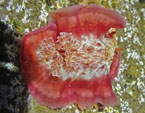
flared mantle

with opaque flecks
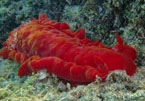
dark
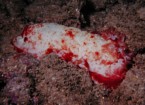
senescent?

swimming

with shrimp

predation

mating
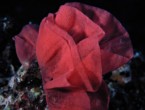
egg mass
_______________
GALLERY

Hexabranchus sandwichensis (Gray, 1850)
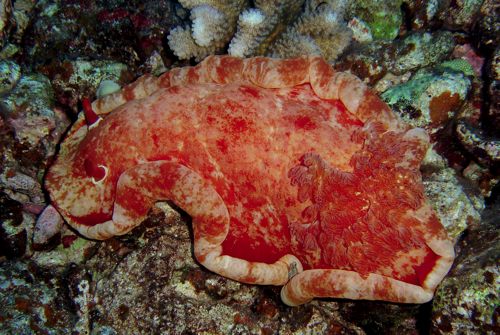
| Maximum size: 300 mm. Identification: This species is the largest and, perhaps, most widely recognized Hawaiian nudibranch. Mature animals are crimson mottled with pink and sometimes flecked with opaque white. When the animal is at rest, the mantle edge is rolled but, when disturbed, it's flared revealing a dark red margin. The oral tentacles are unusual in that they resemble tiny hands. As with other species of Hexabranchus, it undergoes complex changes in color and form as it matures. Very young animals are cream, decorated with violet spots, and lack broad lateral extensions of the mantle. Maturing animals gradually lose the violet spots and develop cream mottling. The background darkens to golden yellow-orange, then crimson. A "frosting" of opaque white flecks may appear on the notum in very old animals. Rarely, mature animals may be yellowish. (Note 1) It can be distinguished from Hexabranchus aureomarginatus by the lack of a yellow marginal band at all sizes although, rarely, it may have a yellow submarginal band (see photo). See the article on this site for further discussion. Natural history: Hexabranchus sandwichensis is a common nocturnal species that shelters under rocks or in crevices during the day. It lives in protected to moderately exposed rocky areas from < 1 to 55 m (< 3 to 180 ft) and has also been photographed from HURL submersibles at 63 m (207 ft). Rarely, it may be seen in the open during the day. (Note 2) Like many dorids, it obtains protective chemicals from its sponge food and Kay (1979) reports that it feeds on the calcareous sponge Leucetta solida. (Note 3) In addition, it is one of the few that can leave the sea floor and swim when threatened--the "dance" referred to in its common name. When swimming, the mantle margin is unrolled to reveal a dark red band and there is strenuous dorso-ventral flexing, perhaps serving to elicit a startle response or advertise its toxic nature to potential predators. The commensal imperial shrimp, Zenopontonia rex (= Periclimenes imperator), is sometimes found living on its body, often among the gills. (see photo) Its egg mass is large and conspicuous consisting of 1-5 bright pink coils often laid in an exposed location such as the top of a piece of coral rubble or rocky spur (see photo). The eggs are very small and deposited in discrete packets of a few dozen that are embedded in the ribbon. Laying may occur primarily at night. As the eggs develop, the egg mass fades to a pale pink and may become worn and tattered-looking. Defensive chemicals are deposited in the egg mass at much higher concentrations than in the nudibranch itself (Scheuer, 1990) so the masses are protected during their week-long development. Most predators are deterred by the chemicals (Note 4) but Favorinus japonicus, a species of aeolid nudibranch, is not. (Note 5) Distribution: Big Island, Maui, Kahoolawe, Lanai, Oahu, Kauai, Niihau, French Frigate Shoals and Midway (also Johnston Atoll). Taxonomic notes: This species is listed as Hexabranchus sanguineus (Rupell and Leuckart, 1831) in Kay, 1979 and Kay & Schoenberg-Dole, 1991. It's listed as both Hexabranchus marginatus and Hexabranchus cf. pulchellus in Kay & Young, 1969. Animals referred to as H. pulchellus in Kay, 1979 and illustrated as such in Bertsch and Johnson, 1981 are juveniles. It is also listed as H. sanguineus in Hoover, 1998 & 2006 (right photo) (corrected in 5th printing). The drawing labelled Hexabranchus sp. in Edmondson, 1946 is probably this species. Doris cardinalis, Doris sandwichiensis, Hexabranchus cardinalis and Hexabranchus tinkeri are also synonyms. It is one of the species commonly referred to as the "Spanish dancer" in Hawaii and elsewhere. In the 5th printing, Hoover, 2006 refers to is as the "redmargin Spanish dancer." It was previously listed on this site as Hexabranchus pulchellus. Various other sources for Hawaii typically list it as either H. sanguineus or H. pulchellus. See Tibirica, et. al (2023) for further discussion. Photo: PF: about 250 mm: Molokini Islet, Maui; Nov. 20, 2008. Observations and comments: Note 1: Kauai Anew includes photos of an unusual yellowish animal. Except for the atypical background color, its characteristics match this species. Note 2: On Maui, we've only seen this species resting in the open by day on one or two occasions. However, in May, 2012 several animals were observed crawling in the open by day in tide pools and the shallow subtidal on Kauai. This suggests more flexible behavior than our Maui observations with at least some diurnal (or crepuscular?) activity. The daytime sightings were in the morning under cloudy conditions. Note 3: In spite of its chemical defense, we have seen it preyed upon by sponge crabs (Tumidodromia dormia), the splendid pebble crab (Etisus splendidus), the banded spiny lobster (Panulirus marginatus) and the red swimming crab (Gonioinfradens paucidentata): all nocturnal hunters. Regarding the last, PF reported: "...Gonioinfradens paucidentata gripping a live Spanish Dancer which was trying to get away. You can see some damage to the nudibranch near the right claw. After awhile the crab got spooked and ran off with the nudibranch in its claws." (see photo) Note 4: Fish that have not learned of their toxicity may bite the egg masses but almost always let go without completely removing a piece of the ribbon, leaving it dangling. We have also seen green sea turtles (Chelonia mydas) mouthing egg masses but not eating them. Note 5: John Horn photographed an egg mass on Kauai that had been colonized by micro-algae. There's some uncertainty in assigning the mass to H. sandwichensis (John reports that H. aureomarginatus is more common in the area). However, the height of the ribbon is more typical of this species. As far as I can recall, we've never seen micro-algae on an egg mass. Perhaps, some factor could have delayed hatching providing sufficient time for it to colonize? Alternatively, if it's actually an H. aureomarginatus mass, perhaps the masses of that species take longer to hatch or are more vulnerable to algal growth than H. sandwichensis masses? (see photos) |
| Thumbnails |
Species
list |
Family | Next species | Top |